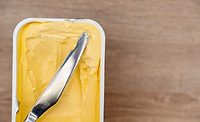Removing Allergens Means Rethinking What “Clean” Means

Controlling the labeling of allergens in a finished product is a fairly straightforward process for products that you intentionally add an allergenic ingredient into. The problem comes from other products made in the facility that were not labeled for allergens. They were not supposed to contain an allergen but were tainted through cross-contact in the processing environment or from shared equipment that was not adequately cleaned between the processing of products with different allergen profiles.
Controlling a shared environment by segregating products using physical separation and separating dedicated equipment and utensils sounds easy, but the cost to do that effectively may be prohibitive for companies in older buildings that were not purposely built for this task.
For companies that have decided to segregate products by time using either the same environment or equipment for products with different allergen profiles on different days, there exists a real risk that some parts of the environment or equipment will not be cleaned sufficiently to remove all traces of the allergen.
Designing a Sanitation Program for Allergens
Sanitation is a key component of the allergen program for companies that make products with different allergen profiles in the same facility. A robust cleaning program for the entire production environment is an absolute requirement for keeping allergenic components out of products not labeled to contain those allergens.
The U.S. Food and Drug Administration (FDA) mandates that food contact surfaces of shared equipment be “visually clean” after running an allergen-containing product and before a non-allergen-containing product (or product with a different allergen profile) is run on that same equipment. Yet, misbranded products (products found to contain allergens that are not declared on the label) continue to be the subject of food product recalls and FDA Import Alerts.
The simple fact is that companies need to go beyond “visually clean” during their verification activities after cleaning shared equipment. I’ve seen it happen over and over in many food processing facilities: Equipment that was monitored and documented to have been “visually clean” by the sanitation crew at night is found to be not clean upon pre-operational inspection by the quality department the next morning.
And just one instance of the quality department being less diligent during that pre-op inspection could mean a serious allergic reaction or even death to a consumer of your food product.
It is vitally important, then, that your sanitation crew understands that “Sanitation to remove allergens” is different from “Sanitation to remove pathogens.” The methods of cleaning and the chemicals used might be the same, but the verification (and validation) activities are different.
When cleaning to remove pathogens, swabs taken for micro testing could be a verification activity. When cleaning to remove allergens, a different type of swab is needed: one that is reactive to the specific allergenic protein you are looking for.
Many of the personnel working in sanitation understand that the equipment needs to be “clean” with no visible food residue, but they may have never known the consequences of doing less than a good job of cleaning. For pathogenic bacteria, a tiny amount left in a hard-to-reach corner or underneath an impeller inside a hard-to-reach area of a piece of equipment might not be enough to cause an outbreak of illness (or food poisoning) in consumers after being mixed into a large volume of product made the next day. Those few cells of bacteria probably need “time” in a favorable temperature and in a favorable growth medium to grow to the larger numbers of cells that might be needed to cause illness.
Allergens, however, do not necessarily need to “grow” to large amounts or need to go through various life stages to produce a toxin that would make consumers ill.
That small amount of allergenic material left between the close-fitting parts of the equipment or underneath the scraper blades in that kettle could be pushed out with the next batch of product and be sufficient to cause a severely allergic consumer to have a reaction or even die.
Putting the Right Tools in Place
At the end of a sanitation shift, the equipment and floors of a wet-cleaned environment are wet and most likely are shiny and look clean to an observer. The “film” or “residue” that the quality assurance (QA) person will find tomorrow morning on the dry equipment is not visible tonight while it’s still wet. To do a better job of monitoring for the presence of allergenic material on the “cleaned” equipment, and verifying that “visually clean” is really clean enough, sanitation supervisors need to be given better tools and better training.
Swabs
The use of new, super-sensitive swabs for ATP detection where even trace amounts of protein are detected might alert a sanitation supervisor that the piece of equipment is not really “clean” before releasing the room to production. Or, that same supervisor might use enzyme-linked immunosorbent assay-specific swabs to see if there is a color change—looking for the specific allergenic protein that had been run on that equipment before the cleaning took place—before determining that sanitation is finished for the night.
Proper training
Another issue that I’ve often seen in the past is the failure of the person doing the post-cleaning inspection to actually get a look at the hard-to-reach areas of a piece of equipment. Training by a longtime inspector, auditor, or QA person could help this problem if those types of people would share some of their “tricks of the trade,” such as using a mirror with an extendable handle for inspection. Another “tool” that I’ve seen used very effectively is a long, thin blade-type instrument (such as a shiny metal icing spreader) used in conjunction with a narrow-focus flashlight to help get a look under and between tight spaces inside equipment or between conveyor linkages, and to provide a reflected image of that area that is not possible from the view you have from standing in front of it.
Equipment
A very stubborn piece of equipment might have a hidden area where product hangs up, which is only discovered when particles of material distinctly belonging to yesterday’s product just “appear” in today’s batch of product, even though the piece of equipment was rinsed out several times before the start of today’s production. For this type of situation, the only way to be sure that all the hung-up product from yesterday is no longer there might be to fill the piece of equipment with water and then test the water for the presence of the allergen. It might even be that water won’t remove all the hung-up product, but that you will have to push some amount of today’s product through the line, stop the line, do a thorough inspection of that product, and then test the product with allergen-specific swabs. Once you’ve done that a few times, you’ll know with much more accuracy what amount of product needs to be run through your system (and then discarded because of cross-contact with the allergen from yesterday’s production) before a test will confirm that it is really “clean” of allergen carryover.
My prediction is that after more people really start to inspect the insides and undersides of food processing equipment for cleanliness, they will start demanding that those pieces of equipment be better designed. “Purposely built” for the function of the equipment in the design engineer’s mind sadly seldom includes the question “How will this thing be cleaned once it is in use?”
Too often, the people who make the decisions about purchases of large-price-tag equipment are not knowledgeable about sanitation and food safety. They need dedicated food safety professionals to look for all those details that the design engineers never took into consideration!
Learning from Experience: Educating the Designers
My own experiences with custom-manufactured pieces of food processing equipment were extremely bad experiences for the people I was buying from. When contracting for the equipment to be built, I required that I would be allowed to inspect the piece of equipment while it was still at the manufacturer’s (machine shop) location and before it could be transported to my location. In each case, I refused to take delivery of the equipment until after a number of changes were made. And only after several such inspections (and refusals to take delivery) did the manufacturers get the piece of equipment to meet with my approval regarding cleanability.
Some other examples: A spacer that the engineers put into parts of my equipment was simply a long bolt with a stack of stainless steel washers put between some parts to make it “fit.” That was completely unacceptable to me because spillage of (liquid) product onto that spacer would allow a tiny bit of nutrient-rich liquid to run down between each of those surfaces and create an excellent growing environment for bacteria in a place that was not accessible for cleaning. When I pointed out that I would not accept this, the design engineer demanded to know, “Well, what do you want me to do about that? I needed to create that amount of space in that location.” I replied, “You told me that you could make any shape out of moldable plastic. Now that you know the exact length of the space needed there, make me one piece of molded plastic to replace the bolt with the stack of washers. This one piece will not have all those tiny spaces that would collect food and grow bacteria.” My solution was simpler and actually cheaper to build than a whole long stack of stainless steel washers.
Another example: After putting together a custom piece of equipment with a conveyor running along the top length of it to carry bottles of liquid product, the engineers had left various openings in the sides of the housing under the conveyor. Each of those openings would have let spilled product run inside, where it was not accessible for easy cleaning. The engineers claimed that they had needed those openings to get things inside the housing and be able to see what they were doing when assembling the thing. I requested that now that they were done, all of the openings in the sides needed to be closed with sanitary welds. I also needed a drop-down door system to be installed on the underside of the housing to make the inside area (with all those electrical components) water resistant for the sanitation crew but accessible for maintenance and the eventual replacement of parts.
We all know that to remove all food debris from a non-solid belt conveyor, the belt needs to be removed for the proper cleaning of both the top and bottom surfaces. An engineer built one for me and then was very happy to show me how “easy” it was to remove. He said, “Anyone can take this punch and a hammer and remove the metal rod holding the links together at any point on the belt. Very easy for your cleaning crew.” Oh boy! He actually thought that would make me happy? Of course not!
I pointed out that I didn’t think anyone would give members of their sanitation crew a hammer and punch for disassembling a belt because they would obviously use excessive enthusiasm for that task and quickly turn the belt and pretty shiny aluminum side rails into a mangled, damaged mess. I wanted one easily removable pin, with a handy loop pull ring installed, so that the same place could be taken apart each time without the need for a hammer and punch. Oh, and by the way, pull pins needed to be installed at the edge of the stripe. “What stripe?” asked the engineer, “the belt is one solid color.” I replied that I had specified in my original order that I would be provided with two belts in two different colors. The engineer said, “That doesn’t help. Each belt is a solid color for the entire length. There are no stripes on them.” I replied, “Take six links from each color belt and swap them. I need an easily seen stripe on each belt.” As you might have guessed by now, the engineer hated to even ask me why, but I explained that having a different-colored stripe on the belt made it easy for my sanitation people and my QA people to watch the entire belt run and do visual sanitation checks and belt inspections. That also allowed my QA people to make sure that they were swabbing different areas of the belt each time, so that they didn’t create a false sense of “clean” by sampling the same area over and over, making it cleaner each time they swabbed it.
The other type of mistake that food processors often make in relation to equipment and sanitation is when installing equipment. To make the equipment fit into a space that is already tight with other things, they place the equipment too close to a wall or too close to other pieces of equipment, so that it is very difficult for people to get into the right location for proper cleaning performance. Your employees cannot be blamed for doing less than a great job of cleaning when they cannot physically reach that entire side of the equipment that is right up next to the wall. Likewise, is it the sanitation person’s fault that you installed a piece of equipment too tall for him to reach but placed in a location surrounded by open drain lines where a ladder cannot safely be set up? More thought needs to go into the design, installation, and setup of equipment for it to be more cleanable and for allergen carryover from shared equipment to become a thing of the past.
Donna F. Schaffner is the associate director of food safety, quality assurance, and training at the Rutgers Food Innovation Center.
Looking for a reprint of this article?
From high-res PDFs to custom plaques, order your copy today!








